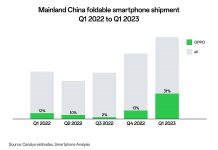TV24 Desk: The iPhone 12 and 12 Pro are here and mark the beginning of a new generation of iPhone. Support for 5G, a new hardware design and camera improvements are a significant step away from the iPhone X generation of devices. This is nothing new. Apple did something similar in 2010 with the iPhone 4 and in 2014 when it released the iPhone 6 and 6 Plus.
There is one big difference with the iPhone 12 generation, though. It’s the first time there are four new iPhones at once: the iPhone 12, iPhone 12 Mini, iPhone 12 Pro and iPhone 12 Pro Max. If you want to go small and reap the benefits of a lower price there’s the Mini. If you want the biggest iPhone with the newest in iPhone cameras, get the Pro Max. But that leaves the 12 and 12 Pro which are similar (like basically-the-same-phone similar). That’s not necessarily a bad thing

The iPhone 12 and 12 Pro are the same size. They both have the same design, the same display, the same insanely fast A14 Bionic chip, the same 5G support, the same selfie, wide and ultrawide cameras. Heck, they both come in blue. (Technically, the 12 Pro is Pacific blue.) This is a departure from the base and pro models from last year. The $699 iPhone 11 and $999 iPhone 11 Pro were similar but had enough differences to distinguish themselves from each other.
The $829 iPhone 12 (or $799 if you activate it on a carrier when you buy it) is $130 more than the iPhone 11 when it was released. An iPhone 12 with 128GB of storage (the same as the baseline 12 Pro) costs $879 (sans carrier discount) which is only $120 less than the $999 iPhone 12 Pro. It’s best to think of the iPhone 12 and 12 Pro as “better” and “best” versions of the same phone.
Prices start in the UK at £799 for the iPhone 12 and £999 for the 12 Pro. In Australia they start at AU$1,349 for the 12 and AU$1,699 for the 12 Pro. See the chart at the bottom for a full pricing breakdown.
IPHONE 12 VS. 12 PRO VS. IPHONE 11
| iPhone 12 | iPhone 12 Pro | iPhone 11 | |
|---|---|---|---|
| Price off-contract (USD) | $829 (64GB), $879 (128GB), $979 (256GB) | $999 (128GB), $1,099 (256GB), $1,299 (512GB) | $599 (64GB), $649 (128GB), $749 (256GB) |
| Camera | 12-megapixel (wide), 12-megapixel (ultrawide) | 12-megapixel (wide), 12-megapixel (ultrawide), 12-megapixel (telephoto) | 12-megapixel (wide), 12-megapixel (ultrawide) |
| Storage | 64GB, 128GB, 256GB | 128GB, 256GB, 512GB | 64GB, 128GB, 256GB |
Now there are many people who will just get the iPhone 12 because it doesn’t cost a thousand dollars and it’s a great phone. Which it is. And there are many people who will get the iPhone 12 Pro because it is more premium. Which it is. Either way, you’re getting an amazing phone with the best overall camera system you can find.
During my time with both phones, I found myself picking the 12 Pro more. Not because it had a telephoto camera or lidar, which the 12 lacks: I preferred the matte textured back, the shiny stainless steel band around the sides and the fact that the 12 Pro, despite weighing nearly an ounce (25 grams) more, felt solid and premium in my hand.

The iPhone 12 and 12 Pro have the same 5G support
It’s brilliant that both the 12 and 12 Pro can connect to sub-6 and mmWave 5G here in the US. One phone doesn’t have better 5G support than the other. They are both the same.
I tested these phones in Greenville, South Carolina on both T-Mobile’s 5G network and Verizon’s Nationwide 5G (the non-mmWave version without the bonkers speeds). I was impressed with the coverage both carriers offered, but not always with the consistency of 5G speeds. Using the app SpeedTest, the iPhone 12 on T-Mobile recorded download speeds between 10.4 and 14.9 megabits per second, while the iPhone 12 Pro on Verizon clocked in between 97.9 and 104Mbps for downloads.
Speed tests aside, there isn’t a killer app that can show off how 5G is pushing things forward. Right now, you’ll see a lot of reviews showing you SpeedTest scores and how fast you can download season 3 of The Marvelous Mrs. Maisel on Amazon. That said, most iPhone owners tend to keep their phones for years. Even if you don’t experience fast 5G speeds now, at least your phone will be able to handle them when they arrive down the line.
Connecting to 5G can tax your phone’s battery life. Apple implemented a clever software feature called Smart Data mode, which balances data needs, speed and power. Smart Data looks at a number of factors to determine whether you need to use 5G. If you don’t, your iPhone will switch to a 4G connection. Smart Data can even switch between different bands of 5G. You can override Smart Data and select to have 5G connectivity all the time. https://playlist.megaphone.fm/?e=CBS9020810996
One cool thing about 5G on the iPhone 12 and 12 Pro was that it let me make HD FaceTime calls over cellular. More 5G things like that, please.
Apple iPhone 12 Pro has a bold, striking no-frills look


The iPhone 12 and 12 Pro have an iPhone 5 design
One of the first things I noticed about the iPhone 12 is its “slabular” beauty. Apple’s idea of premium differs from the flash and spectacle we see in flagship Android phones. Body colors don’t appear to morph from one to another depending on the light. The screen doesn’t wrap around the edges. In fact, the iPhone 12 and 12 Pro don’t have curved edges at all.
Instead, a straight-edged polished stainless steel band defines the iPhone 12 Pro (it’s matte aluminum on the 12), much in the way it did on the iPhone 5, 5S and SE, just without the chamfered edges. The iPhone 12 and 12 Pro have a bold, striking look without any frills. The build and finish on the 12 Pro are extraordinary.
The iPhone 12 is also defined by a stunning OLED panel, which Apples calls a Super XDR display. Gone is the LCD found on the iPhone XR and 11. Besides the contrast and resolution, the squared-off sides seem to push the display up and forward. When the phone is on its back, it’s as if the rest of the phone is holding up the display while trying not to be seen.
Both phone screens are covered with a ceramic shield, a new material that starts off as glass and is infused with nano-ceramic crystals. (After the infusion, it’s no longer considered glass.) Apple claims it offers four times the protection when dropped. I’m not sure exactly how that number was calculated by Apple, but I look forward to my colleagues putting the 12 and 12 Pro through a series of drop tests. The iPhone 12 and 12 Pro are both rated IP68 for water- and dust-resistance and can withstand being submerged in water to a depth of 6 meters for 30 minutes. In the time I had the phones, both handled spills, light rain and minimal submerging in water just fine.

iPhone 12 and 12 Pro capture excellent photos and videos
The cameras received hardware, software and processing upgrades. While other phones might have a standout camera feature (like the Galaxy S20 Ultra’s 100x Space Zoom) that these iPhones lack, the iPhone 12 and 12 Pro can capture excellent photos and video and deliver consistently fantastic images. Here’s a sample taken in a range of different environments and lighting.
The iPhone 12 has the exact same cameras as the iPhone 12 Pro, except for the telephoto camera and lidar. But these phones aren’t just dependent on hardware to take good photos and videos. Apple’s new A14 Bionic chip, along with software and machine learning, adds improvements to everything.
For example, the 12 and 12 Pro have the same hardware for their ultrawide-angle camera as last year’s 11 and 11 Pro. But the 12 and 12 Pro have software to correct the lens distortion. Take a look below at these ultrawide-angle photos of a brick wall. in the iPhone 11 photo, notice how the corners of the brick wall look like they’re bending.https://cdn.knightlab.com/libs/juxtapose/latest/embed/index.html?uid=1aa1eb5a-129f-11eb-83c8-ebb5d6f907df
The main wide-angle camera on both phones has a faster lens that lets in more light. The new lens, combined with Smart HDR 3, yields truly amazing photos with accurate colors and solid dynamic range. Night Mode is now on the ultrawide and selfie cameras. I’m shocked at how good some Night Mode photos came out, even the selfie portraits I took! The telephoto camera on the 12 Pro is a huge step up in zoom compared to the iPhone 12. But there are a number of phones that offer much longer zooms with better results.
In terms of video, especially on the iPhone 12 Pro, the focus is fantastic and was able to track me even when I was shooting at night. And that’s because of the lidar sensor. In fact, some of the clips in my review video were shot on the iPhone 12 Pro.
iPhone 12 and 12 Pro are the fastest phones
The cameras aren’t the only thing that the A14 Bionic chip improves. It’s fast, but it’s hard to see the increased speed over the A13 chip, which is still peppy. The A14 chip is as much about power now as it is about future-proofing your phone so it can handle iOS 17 in a few years.
In performance benchmark tests, the iPhone 12 and 12 Pro recorded the highest scores of any phones we’ve ever tested. See the results below
NOTE:
Longer bars indicate better performance
In terms of battery life, I typically got through a day and the next morning OK. I was able to run a single battery test with looped video playing at half brightness in airplane mode. The iPhone 12 Pro lasted 15 hours, 56 minutes and the iPhone 12 lasted 17 hours, 14 minutes. I want more time to evaluate the battery life on the 12 and 12 Pro once I’m done reviewing the phones and we have more battery tests to run, so check back to this article for updates.
The phone comes with a USB-C to Lightning cable, which can offer super fast speeds. Apple no longer includes a pair of wired earbuds in the box or a power adapter, the idea being to minimize hazardous electronic waste. It’s likely this won’t be a problem for you as most people will already have a pair of earbuds and a wall charger to use.
iPhone 12 has perfectly flat sides and it’s wonderful


But here’s where that doesn’t necessarily add up: Since 2012, all iPhones have come with a 5-watt charger USB-A power adapter, which isn’t compatible with the included USB-C cable. Yes, if you already have an old Lightning cable you could use that, or you could buy a USB-C power adapter. Or you could try out Apple’s new MagSafe wireless charging system, but the MagSafe charger (without a wall charger) is $39.
MagSafe uses magnets inside the phone and charger to nestle them into a position that is the most efficient for charging. I really enjoyed using MagSafe. The sound the phone and charger make when they connect is beyond satisfying. There’s even an animation that pops up on screen showing that everything is properly connected. I tried out some MagSafe cases, which work well and allow for wireless charging through the case without losing power
The magnets can also connect to noncharging accessories like a detachable wallet, which you can use with or without a MagSafe phone case. This little business card-sized wallet won me over. I’m excited to see what Apple and third-party companies use MagSafe for.
The iPhone 12 and 12 Pro are amazing phones, but we only have half the picture right now. There’s also the iPhone 12 Mini (which I’m particularly excited about, given its size and price) and the iPhone 12 Pro Max, which maxes out the size of the phone’s display and offers camera improvements that none of the other iPhones 12 have. But that’s just what we know based on the specs. We’ll have to wait until November to see how they work out in reality.
Source : Cnet
































